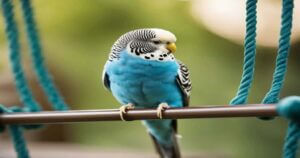Male vs Female Budgies | Which is Better?
Choosing between male and female budgies depends on preferences, physical and behavioral differences. Males are typically more vocal and playful, while females can be quieter but more independent. Males typically have blue ceres, while females have brown or tan ceres. Both make great pets with unique charms.
When it comes to choosing a pet budgie, understanding the distinctions between male and female budgies is crucial. While both genders make delightful companions, they possess unique characteristics that can influence their behavior, appearance, and even their ability to mimic sounds.
In this article, I will delve into the intriguing world of male vs. female budgies, shedding light on the key differences and similarities between these charming avian friends.
So, let’s get started.
Male vs Female Budgies | Exploring the Differences and Similarities

Credit: a-z-animals.com
Budgies, also known as parakeets, are popular pet birds. Understanding their physical differences helps in identifying males and females.
1. Physical Differences
Let’s explore the key physical traits that set them apart.
1.1 Color Variations
Color differences can help distinguish male and female budgies. Male budgies often have bright blue ceres (the area above the beak). In contrast, female budgies usually have brown or light tan ceres. These color variations become apparent as the birds mature.
Juvenile budgies may have pink or purplish ceres, making it hard to tell their gender. As they grow older, the color differences become more noticeable. This makes identifying their gender easier.
1.2 Size And Build
Male and female budgies also differ in size and build. Males tend to be slightly larger with a more robust build. Their heads are often broader and more rounded.
Females are generally smaller and have a more streamlined build. Their heads appear narrower and less rounded compared to males. These size and build differences are subtle but noticeable with careful observation.
| Characteristic | Male Budgies | Female Budgies |
|---|---|---|
| Ceres Color | Bright Blue | Brown or Light Tan |
| Size | Slightly Larger | Smaller |
| Build | Robust and Broad | Streamlined and Narrow |
2. Behavioral Traits

Understanding the behavioral traits of male and female budgies helps in better care. Male and female budgies display distinct behaviors. These differences affect their vocalizations, social interactions, and overall demeanor.
Vocalization Patterns
Male budgies are known for their musical abilities. They often sing more than females. Males use a variety of sounds, from chirps to complex songs. This makes them quite entertaining.
Female budgies are generally quieter. They chirp less frequently and their sounds are simpler. Females focus more on communicating essential needs.
| Behavior | Male Budgies | Female Budgies |
|---|---|---|
| Frequency of Singing | High | Low |
| Sound Complexity | Complex | Simple |
| Communication Focus | Entertaining | Essential Needs |
Social Interactions
Male budgies are often more social and curious. They enjoy interacting with their owners and other birds. Males tend to be more playful and outgoing. They often initiate games and activities.
Female budgies can be more reserved. They may take longer to warm up to new environments. Females are often more cautious and observant. They prefer to establish trust before engaging fully.
- Male budgies: Social, playful, outgoing.
- Female budgies: Reserved, cautious, observant.
3. Health And Lifespan
Male and female budgies have different health issues. Knowing these can help you provide better care.
| Health Issue | Male Budgies | Female Budgies |
|---|---|---|
| Egg Binding | N/A | Common in females. Needs immediate vet care. |
| Hormonal Aggression | Rare | More common. Can cause aggression. |
| Testicular Tumors | Possible. Watch for changes in behavior. | N/A |
Life Expectancy
Budgies generally have a good lifespan, but it varies between males and females:
| Gender | Average Lifespan |
|---|---|
| Male Budgies | 5 to 10 years |
| Female Budgies | 4 to 8 years |
Proper care can extend their lives significantly. Keep their environment clean. Provide a balanced diet. Ensure they have enough exercise.
5. Dietary Needs
Female budgies, especially those laying eggs, need more calcium. Males might benefit from extra vitamins to maintain vibrant feathers.
| Food Type | Male Budgies | Female Budgies |
|---|---|---|
| Seeds | High Preference | Moderate Preference |
| Fruits | Moderate Preference | Moderate Preference |
| Vegetables | Moderate Preference | High Preference |
6. Habitat Requirements
Environmental enrichment keeps budgies mentally and physically active. Male and female budgies enjoy different types of toys and activities. Males often prefer mirrors and bells. Females may enjoy shredding toys and ladders. Provide a variety of toys to keep them engaged.
- Mirrors
- Bells
- Shredding Toys
- Ladders
Rotate toys weekly to prevent boredom. Add perches of different sizes and textures. Natural wood perches are great for their feet. Ensure there are multiple perches to allow movement within the cage.
Also, include a cuttlebone for calcium. Fresh water and a varied diet are essential. Budgies love leafy greens and fruits. Change their food and water daily to maintain hygiene.
7. Training And Bonding
Training and bonding with budgies can be a joyful experience. Both male and female budgies have unique traits. Understanding these traits helps in effective training and bonding. Whether you have a male or female budgie, patience and consistency are key.
Basic Commands
Teaching basic commands to your budgie helps in better interaction. Male budgies are usually more vocal. They often learn to mimic sounds and words. Female budgies are less vocal but can still learn commands.
Start with simple commands like “step up” and “come.” Use a perch or your finger for the “step up” command. Hold a treat in your other hand. Repeat the command and reward your budgie when they comply. Consistency is important for both male and female budgies.
Building Trust
Building trust with your budgie is crucial. Male budgies often bond more quickly. They are curious and social. Female budgies may take more time to trust. They tend to be more cautious.
Spend time near your budgie’s cage. Talk to them softly. Offer treats through the cage bars. Avoid sudden movements. Gradually, your budgie will start trusting you. Once trust is established, training becomes easier.
| Aspect | Male Budgies | Female Budgies |
|---|---|---|
| Vocal Abilities | High | Moderate |
| Trust Building | Faster | Slower |
| Training Response | Quick | Steady |
By understanding these differences, you can tailor your training and bonding approach. Whether male or female, your budgie will thrive with love and patience.
8. Breeding Considerations
Breeding budgies can be an exciting adventure. Understanding the differences between male and female budgies helps ensure a successful breeding process. This section focuses on key aspects like mating behavior and caring for chicks.
Mating Behavior
Male budgies often initiate the mating process. They perform dances and sing to attract the female. Males also bob their heads and fluff their feathers. This display shows their interest in mating.
Female budgies respond if they are interested. They may lower their body and raise their tail. This indicates they are ready to mate. Successful mating usually occurs during the early morning hours.
Caring For Chicks
Once the eggs hatch, both parents play roles in caring for the chicks. Male budgies typically feed the female as she stays with the chicks. The female then feeds the chicks.
Chicks need constant warmth and food. The nesting box should be kept clean. Daily checks ensure the chicks are healthy.
The table below outlines the key responsibilities:
| Role | Male Budgie | Female Budgie |
|---|---|---|
| Feeding | Feeds the female | Feeds the chicks |
| Warmth | Not applicable | Provides warmth |
| Nesting Box Maintenance | Not applicable | Keeps it clean |
- Use a suitable nesting box for comfort.
- Ensure a balanced diet for both parents.
- Monitor the health of the chicks daily.
Common Myths About Male and Female budgies
Many people have misconceptions about male and female budgies. These myths can affect how we care for them. Let’s clear up some of these common myths.
1. Gender Stereotypes
One common myth is that male budgies are always more colorful. While males often have brighter colors, some females can be very colorful too. It’s not a sure way to tell their gender.
Another stereotype is that males are better talkers. Male budgies do tend to mimic sounds more. But females can learn to talk too. Both genders can be chatty and fun.
2. Behavior Misconceptions
People often think male budgies are friendlier. This is not always true. Both males and females can be equally friendly. Their behavior depends more on how they are raised.
Another common belief is that female budgies are more aggressive. Females may be more protective of their space. But with proper socialization, they can be just as gentle as males.
Training: Both genders can be trained.
Companionship: Both make great pets.
Activity Levels: Both are active and playful.
| Myth | Truth |
|---|---|
| Male budgies are more colorful | Both genders can be colorful |
| Males are better talkers | Both can learn to talk |
| Males are friendlier | Friendliness depends on upbringing |
| Females are more aggressive | Both can be gentle |

Frequently Asked Questions
Are Male Budgies Calmer Than Females?
Male budgies tend to be calmer than females. They are often more sociable and easier to tame. Female budgies can be more territorial and aggressive.
Are Male Or Female Budgies Better Talkers?
Male budgies are generally better talkers. They tend to learn and mimic words more easily than females.
How To Tell Male From Female Parakeets?
Male parakeets have a blue or purple cere, while females have a brown or white cere. Males are often more vocal.
Sum Up
In conclusion, when comparing male and female budgies, it is important to consider their unique characteristics and behaviors. Male budgies are known for their vibrant plumage and ability to mimic sounds and speech, making them popular as pets.
On the other hand, female budgies are typically more reserved and may not exhibit the same level of vocalization. Understanding these differences can help potential budgie owners make an informed decision when choosing a pet.
Whether you prefer the striking appearance of a male budgie or the gentle demeanor of a female budgie, both genders make wonderful companions.
Ultimately, the choice between a male or female budgie should be based on personal preference and the desired qualities in a pet bird.
Hello Dear, I'm Poli Kolymnia, owner of many birds (including budgies).
With a deep passion for these feathered companions, I'm here to share my expertise and extensive knowledge on birds care.
My articles cover essential topics like diet, housing, care, and health, providing practical tips to help you create a happy and thriving environment for your birds.







